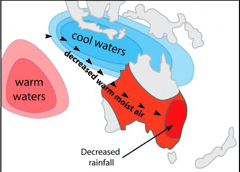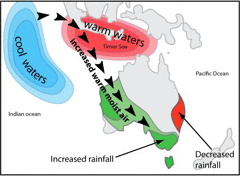Behind the Big Dry
Air Date: Week of February 13, 2009

The Indian Ocean dipole’s positive phase: warm water leads to weaker, drier winds, and less rainfall on southern Australia. (Courtesy of the UNSW Climate Change Research Centre)
Scientists are struggling to understand the climatic conditions behind the unusually severe drought that has wreaked havoc on southeastern Australia. New research suggests the answer might lie in the Indian Ocean, where the disruption of a natural cycle is keeping moisture at bay. Climatologist Caroline Ummenhofer, a research fellow with the University of New South Wales, talks with host Bruce Gellerman about how the warming Indian Ocean could be compounding the effects of rising temperatures in an already warming temperatures.
Transcript
GELLERMAN: From the Jennifer and Ted Stanley Studios in Somerville, Massachusetts - this is Living on Earth. I’m Bruce Gellerman, in for Steve Curwood.
Australians call it the Big Dry. For 15 years southeastern Australia has been suffering from a severe drought leaving it bone dry and parched, perfect conditions for the deadly bushfires that recently tore through the region destroying forests and farms, devastating homes and lives.
Caroline Ummenhofer is a fellow at The University of New South Wale’s Climate Change Research Center. She says South East Australia has had droughts before but never like this.

There has been no negative—or wet—phase of the Indian Ocean dipole for 17 years, leaving southeastern Australia parched. (Courtesy of the UNSW Climate Change Research Centre)
UMMENHOFER: It’s unprecedented in its intensity. And it has been unclear what has caused this big dry. Now Australia has had major iconic droughts over the last 120 years like the Federation Drought, the World War II Drought, but this latest drought, The Big Dry, is really something that we haven’t seen before because it’s so intense.
GELLERMAN: Well, what is causing this? If you’ve never seen something like this before, how do you account for it?
UMMENHOFER: What is surprising is that normally drought conditions over eastern Australia are associated with El Nino, La Nina cycles in the Pacific Ocean. These are temperature changes that affect the rainfall and circulation over the whole Pacific Ocean and the surrounding areas. However, what we could find is that, El Nino is not able to explain this latest drought, The Big Dry. Instead what we found is actually that the cause lies in Indian Ocean temperatures
GELLERMAN: So something is happening that’s different in the Indian Ocean. What is it?

The Indian Ocean dipole’s positive phase: warm water leads to weaker, drier winds, and less rainfall on southern Australia. (Courtesy of the UNSW Climate Change Research Centre)
UMMENHOFER: Yes. The Indian Ocean has a similar phenomenon to the El Nino, La Nina cycle. It’s called the Indian Ocean Dipole, and it’s a naturally occurring phenomenon and has been known for some time to influence Australian climate and Australian weather. The dipole oscillates between positive and negative phases and has neutral years in between as well, so the negative and the positive are the two extremes. And the normal wet conditions that you experience over south-east Australia are linked to the negative Indian Ocean dipole event which we haven’t seen over the last seventeen years.
GELLERMAN: And the negative effect would bring wet weather. And so you’ve had this prolonged dry weather.
UMMENHOFER: Exactly. During the negative phase we have wet conditions over the southeast of Australia. And the last India Ocean Dipole event of the negative phase occurred in 1992. That is unusual. We haven’t anywhere in the record over the last 120 years that we’ve investigated seen a similarly prolonged period without a single negative event, and therefore, this drought and sustained drought conditions in the southeast.
GELLERMAN: Well could it be that the Indian Ocean is getting warmer and that’s why you’re getting more positive, dry events in southeast Australia?
UMMENHOFER: The Indian Ocean is certainly been getting warmer. Most of the earth’s oceans have been getting warmer, but the Indian Ocean in particular. And there might be indications that this could lead to changes in the characteristics of Indian Ocean dipole events.
GELLERMAN: You know back in 2007 the United Nations Panel on Climate Change predicted that there was going to be an increase in intensity and frequency of droughts right there in southeast Australia.

Caroline Ummenhofer, the lead scientist on the dipole and drought study. (Courtesy of the UNSW Climate Change Research Centre)
UMMENHOFER: Yes. This is consistent with predictions or projections what could be expected under global warming or climate change. But this is not work that I have done, like we have not, so far, investigated if there has been changes in the infrequency of the Indian Ocean Dipole. However other work by colleagues have suggested that we might be moving toward more positive events in the Indian Ocean Dipole and that is linked to a strengthening East Asian monsoon and to drier conditions over Australia, which wouldn’t be very good news for Australia.
GELLERMAN: So if I hear you correctly, you really can’t say whether climate change is responsible for this very unusual weather that you’re having in southeast Australia.
UMMENHOFER: That is correct. It’s not possible or very hard to attribute a single event to climate change. However, if you think about a warmer background state overall, then extreme events on this warmer background state will probably be more intense or more serious. And we found actually that the drought conditions have been exacerbated in the southeast due to recent higher temperatures, so it’s not just the lack of rain fall. But because of higher air temperatures, we also see more evaporation and, therefore, a worsening of the drought.
GELLERMAN: Caroline Ummenhofer is a fellow at The University of New South Wale’s Climate Change Research Center.
Links
Living on Earth wants to hear from you!
Living on Earth
62 Calef Highway, Suite 212
Lee, NH 03861
Telephone: 617-287-4121
E-mail: comments@loe.org
Newsletter [Click here]
Donate to Living on Earth!
Living on Earth is an independent media program and relies entirely on contributions from listeners and institutions supporting public service. Please donate now to preserve an independent environmental voice.
NewsletterLiving on Earth offers a weekly delivery of the show's rundown to your mailbox. Sign up for our newsletter today!
 Sailors For The Sea: Be the change you want to sea.
Sailors For The Sea: Be the change you want to sea.
 The Grantham Foundation for the Protection of the Environment: Committed to protecting and improving the health of the global environment.
The Grantham Foundation for the Protection of the Environment: Committed to protecting and improving the health of the global environment.
 Contribute to Living on Earth and receive, as our gift to you, an archival print of one of Mark Seth Lender's extraordinary wildlife photographs. Follow the link to see Mark's current collection of photographs.
Contribute to Living on Earth and receive, as our gift to you, an archival print of one of Mark Seth Lender's extraordinary wildlife photographs. Follow the link to see Mark's current collection of photographs.
 Buy a signed copy of Mark Seth Lender's book Smeagull the Seagull & support Living on Earth
Buy a signed copy of Mark Seth Lender's book Smeagull the Seagull & support Living on Earth

